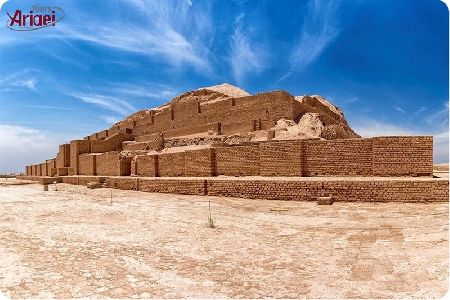Chughazanbil Ziggurat is one of the major archaeological sites in Iran that was created by the Elamite king Untash- Napirsha as a religious building around 13th century BC. The ziggurat has a 100 * 100 m base that served as both a temple and a tomb. It consisted of 5 separately built concentric levels of varying elevation and each level was constructed directly from the ground. This form of architecture (each level built from the ground and not over the previous layer) is what differentiates it and Mesopotamia ziggurats.
The top of the temple was where the most important cultic rituals were performed. There were four gates that the southwestern gate was the main one. On both sides of the entrance gate, guardian bulls and winged griffins glazed in terracotta were placed. The monument was constructed using fired bricks for the casing of structure and sun-dried Bricks as filler. in the past, the exterior of the monument was decorated with blue and green glazed fire bricks, inlaid ivory mosaics, as well as opaque glass mosaics depicting prancing creatures. Around the main ziggurat were other small shrines that were dedicated to other the Elamite gods, the holy city was also protected by three defending walls.
Chughazanbil in 1979 Chughazanbil was listed by UNESCO as the first world heritage of Iran.
